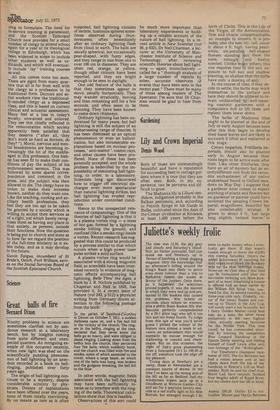'Gardening
Lily and Crown Imperial
Denis Wood
Both of these are outstandingly beautiful and have a reputation for succeeding best in cottage gardens where it is true that they are often seen. Both, in my experience, can be perverse and difficult to grow.
The Madonna lily is Lilium candidu rn, indigenous probably in the Balkan peninsula, and, according to Patrick Synge in his Guide to Bulbs, cultivated since the days of the Cretan civilisation at Knossos, at least 1,400 years before the birth of Christ. This is the Lily of the Virgin, of the Annunciation, firm and chaste, unapproachable, an example to sinners. It is probably also the best lily, tall, usually about 4 ft. high, having pearlwhite, six-petalled, bell-shaoed flowers standing out from the stem, strongly and freshly scented. Unlike many others, this one requires lime in the soil, exposure to full sun and shallow planting, so shallow that the bulbs have only a dusting of soil.
In the course of time, if they decide to settle, the bulbs may work themselves to the surface and here they should be allowed to remain undisturbed by well-meaning neurotic gardeners with a compulsive itch to lift them and replant them lower down.
The bulbs of Madonna lilies ought to be planted at the end of July or early August because soon after this they begin to develop their basal leaves and are likely to succumb if lifted and replanted at this stage.
Crown Imperials, Fritillaria imperialis, should also be planted early in August because their roots begin to be active soon after then. Like other fritillaries, they have an air of mystery but an entirelydifferent one from the recondite enchantment of our native snakeshead found in Oxford meadows on May Day. I suppose that a gardener soon comes to expect anything of plants and flowers but no gardener or painter could have invented the amazing Crown Imperial, magnificent, beautiful but also unbelievably strange. It grows to about 4 ft., has large long slightly twisted leaves' to
about half-way up the stem, then a clear stem for perhaps 18 inches to 2 ft. and, at the top of this, a tufted crown of twisted leaves from which large bell-shaped flowers hang downward-looking, in a ring. They can be lemon-yellow, orange or dark red. Gerard in his description wrote," In the bottom of each of these bels there is placed sixe drops of most cleare' shining sweet water, in taste like sugar, resembling in shew, faire orient pearles " These drops of nectar have been likened to tears because the Crown Imperial was too proud to bow its head when Christ passed on his way to Calvary.
I have found it very difficult to keep this plant in spite of repeated attempts in a rather ordinary brick-earth type of soil. It probably needs heavy clay or a deep, cool, rich loam with full exposure to the sun, and when it succeeds as1 have seen it do, it will increase so rapidly that bulbs ought to be lifted and divided every few years. Unlike the Madonna lily, these bulbs should be put in six inches deep on their sides so that water going through the soil should not collect in the marked depression in the top of the bulb. The bulbs and, indeed, all parts of the plant, smell strongly of fox. Poor Mr Bowles lamented this in My Garden in Spring when he wrote that it "possesses an awful stink, a mixture of mangy fox, dirty dog-kennel, the small cats' house at the zoo and Exeter railway station, where for some unknown reason the trains let out their superfluous gas to poison the travellers."































 Previous page
Previous page